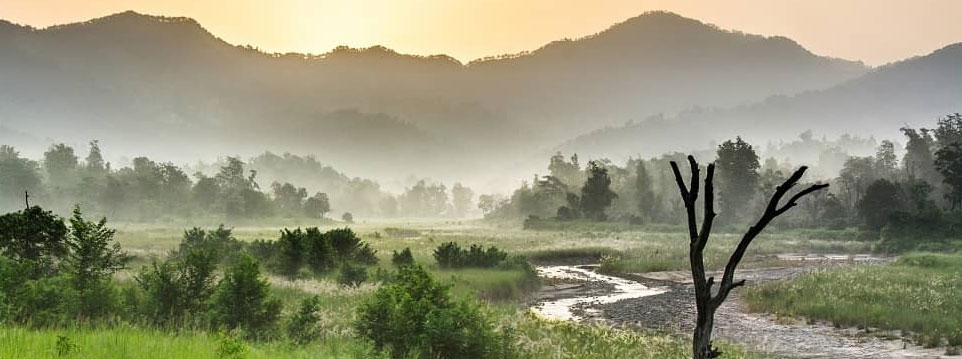Day Trip Options to Rajaji National Park from Rishikesh
By JAGAT- 10/March/2025: Nestled in the foothills of the Himalayas, Rishikesh in Uttarakhand, the "Yoga Capital of the World" serves as a spiritual sanctuary. Renowned for its ashrams, meditation centres, and the sacred Ganges River, this vibrant town attracts seekers from around the world looking to experience inner peace. Beyond its spiritual allure, Rishikesh is also an adventure hub, drawing thrill-seekers with exhilarating activities like white-water rafting in the Ganges, bungee jumping from towering heights, and trekking through picturesque trails. Popular tourist attractions include the iconic Laxman Jhula and Ram Jhula suspension bridges, the Beatles Ashram (Chaurasi Kutiya), Triveni Ghat for the mesmerizing Ganga Aarti, Neelkanth Mahadev Temple and the serene Neer Garh Waterfall.
While these experiences make Rishikesh a must-visit destination, an exciting and lesser-explored adventure lies just on its outskirts - the Rajaji National Park. Located merely a short drive away, this vast wildlife sanctuary offers a refreshing escape into the wilderness. Known for its diverse flora and fauna, the park is home to elephants, tigers, leopards, and countless bird species. Visitors can explore the Jhilmil range, a serene grassland known for swamp deer, or venture into the Chaurasi Kutiya zone, where abandoned meditation huts merge with the wild, offering a unique blend of nature and history.

A Brief Overview of Rajaji National Park
Rajaji National Park derived its name from the famous Indian independence activist, Raja C. Gopalachari. The borders of the national park are spread across a vast area, covering the Chilla and Motichur Range near Haridwar, the Jhilmil and Chaurasi Kutiya Zones near Rishikesh to the Mohand Range in Dehradun. Although a lesser-known wildlife gateway, Rajaji National Park is steeped in a significant population of flora and fauna. Even, tigers from Corbett National Park have been transferred to Rajaji, according to recent news, thereby escalating the chances of spotting tigers. The landscape of Rajaji is indeed mesmerising. The open grassland areas, dense forests, chirping of birds and the jeep driving deep inside the forest, altogether provide a fascinating experience. Gradually gaining prominence among nature and wildlife enthusiasts, it is better to go for Rajaji online safari booking to reserve your safari in advance. The jeep safaris are conducted in morning and evening slots from mid-October to mid-June. The timings of the safaris vary according to the seasons. Therefore, for a seamless wildlife experience, choose the smart move of advance booking of safari.
The Rajaji Safari and Exploration near Rishikesh
Jhilmil Range - The Jhilmil Range, a serene and picturesque expanse within Rajaji National Park. Often referred to as the buffer zone of Rajaji Tiger Reserve, the Jhilmil Jungle Safari takes visitors on an approximately 30 km drive through a diverse landscape of dense forests, sprawling grasslands, and the meandering Ganges River One of the highlights of this region is Jhilmil Jheel, a marshy wetland near the Chidiyapur Forest Range. This area serves as a crucial habitat for various wildlife species, most notably the swamp deer (barasingha), a rare and protected species in India. Along the vast Patera grasslands, one can often spot herds of swamp deer, spotted deer, sambar, and wild boars grazing peacefully. The region is also known for frequent leopard and elephant sightings, adding to its allure. Additionally, Jhilmil Range is a haven for birdwatchers, attracting both migratory and resident birds.
Chaurasi Kutiya Zone - Chaurasi Kutiya, popularly known as The Beatles Ashram, is a historic meditation retreat located near the banks of the Ganga River in Rishikesh. Established in 1963 by Maharishi Mahesh Yogi, it gained worldwide recognition in 1968 when The Beatles, along with other renowned personalities, visited to learn Transcendental Meditation. Their time at the ashram proved highly creative, inspiring several songs that later featured on iconic albums like The White Album and Abbey Road. Nestled within Rajaji National Park, the ashram offers a peaceful retreat amid lush greenery, enhancing its spiritual atmosphere. Vehicles are not permitted inside, allowing visitors to explore its tranquil surroundings on foot, marvelling at the abandoned meditation huts and vibrant graffiti-adorned walls that capture the essence of this legendary site.